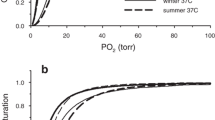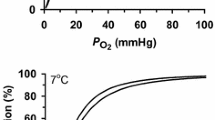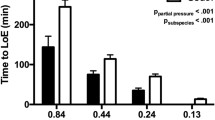Summary
Snakes,Vipera berus, were acclimated to 5 and 25 °C for 3 months preceding measurements of O2 uptake and blood respiratory properties. O2 uptake measured at the lower acclimation temperature (5 °C) shows lower values for the cold-acclimated snakes. Measured at 25 °C cold-acclimation results in O2 uptakes slightly higher than in warm-acclimated snakes. The temperature sensitivity (Q10) of aerobic metabolism in thus higher for the cold-acclimated snakes being 3.17 compared to 2.11 for the warmacclimated.
O2-Hb dissociation curves of whole blood from the two acclimation groups show a marked increase in O2 affinity associated with cold-acclimation independent of blood pH. The shift in O2 affinity correlates with a marked decrease in red cell organic phosphate concentration (ATP) in cold-acclimated snakes. The temperature sensitivity of the O2-Hb binding expressed by the ΔH values was rather uniform at about −11 kcal·mol−1 (O2) for both acclimation groups. The CO2 Bohr factor in cold-acclimated blood at −0.55 was about double that in warm-acclimated. Then value for both acclimation groups increased with higher temperatures. Hematocrit and blood O2 capacity were higher in the cold-acclimated snakes.
The acclimation effects on O2 uptake, O2-Hb affinity and the Bohr effect, are opposite to those obtained earlier on reptiles at lower latitudes. It is discussed how a downward translation of the O2 uptake-temperature curve and a high thermal sensitivity (Q10) may be adaptive for species at latitudinal extremes where the active season is short and diurnal temperatures fluctuate widely. It is further discussed how a change in O2 affinity by its influence on the capillary to cellular O2 gradients may affect the aerobic metabolism.
Similar content being viewed by others
References
Benedict, F.G.: The physiology of large reptiles, pp. 425. Washington: Carnegie Inst. Wash. Publ. 1932
Benesch, R.E., Benesch, R.: The mechanism of interaction of red cell organic phosphates with hemoglobin. Adv. Protein Chem.28, 211–237 (1974)
Benesch, R.E., Benesch, R., Yu, C.I.: The oxygenation of hemoglobin in the presence of 2,3-diphosphoglycerate. Effect of temperature, pH, ionic strength and hemoglobin concentration. Biochemistry8, 2567–2571 (1969)
Bennett, A.F., Dawson, W.R.: Metabolism. In: Biology of the reptilia, Vol. 5, Physiology A, Gans, C. (ed.), pp 127–223. New York: Academic Press 1976
Buikema, A.L., Jr., Armitage, K.B.: The effects of temperature on the metabolism of the prairie ringneck snake,Diadophis punctatus arnyi Kennicott. Herpetologica25, 194–206 (1969)
Bullock, T.H.: Compensation for temperature in the metabolism and activity of poikilotherms. Biol. Rev.30, 311–342 (1955)
Carey, C.: Aerobic and anaerobic energy expenditure during rest and activity in montaneBufo b. boreas andRana pipiens. Physiol. Zool. (in press) (1979)
Coulson, R.A., Hernandez, T., Herbert, J.D.: Metabolic rate, enzyme kinetics in vivo. Comp. Biochem. Physiol.56A, 251–262 (1977)
Fry, F.E.J.: Temperature compensation. Ann. Rev. Physiol.20, 207–224 (1958)
Gahlenbeck, H., Bartels, H.: Blood gas transport properties in gill and lung forms of the axolotl (Ambystoma mexicannum). Respir. Physiol.9, 175–182 (1968)
Grigg, G.C.: Temperature-induced changes in the oxygen equilibrium curve of the blood of the brown bullhead (Ictalurus nebulosus). Comp. Biochem. Physiol.28, 1203–1223 (1969)
Jacobson, E.R., Whitford, W.G.: The effect of acclimation on physiological responses to temperature in the snakes,Thamnophis proximus andNatrix rhombifera. Comp. Biochem. Physiol.35, 439–449 (1970)
Johansen, K., Lykkeboe, G., Weber, R.E., Maloiy, G.M.O.: Respiratory properties of blood in awake and estivating lungfish,Protopterus amphibius. Respir. Physiol.27, 335–345 (1976)
Johansen, K., Weber, R.E.: On the adaptability of haemoglobin function to environmental conditions. In: Perspectives in experimental biology. Vol. 1, Zoology. Spencer Davies, P. (ed.), pp. 219–234. Oxford and New York: Pergamon Press 1976
Kirberger, C.: Temperatur-Adaptation der Sauerstoffbindung des Blutes vonRana esculenta L. Z. vergl. Physiol.35, 153–158 (1953)
Lechner, A.J.: The scaling of maximal oxygen consumption and pulmonary dimensions in small mammals. Respir. Physiol.34, 29–44 (1978)
McCutcheon, F.H.: Hemoglobin function during the life history of the bullfrog. J. Cell. Comp. Physiol.8, 63–81 (1936)
Pough, F.H.: Environmental adaptations in the blood of lizards. Comp. Biochem. Physiol.31, 885–901 (1969)
Straub, M.: Weitere Untersuchungen zur Temperatur-Adaptation der Sauerstoffbindung des Blutes vonRana esculenta L. Z. vergl. Physiol.39, 507–523 (1957)
Sullivan, B., Riggs, A.: Structure, function and evolution of turtle hemoglobins II. Electrophoretic studies. Comp. Biochem. Physiol.23, 449–458 (1967)
Wood, S.C., Johansen, K.: Respiratory adaptations to diving in the Nile monitor lizard,Varanus niloticus. J. Comp. Physiol.89, 145–158 (1974)
Wood, S.C., Lenfant, C.: Respiration: mechanics control and gas exchange. In: Biology of the reptilia, Vol. 5, Gand, C., Dawson, W.R. (eds.), pp. 225–274. New York: Academic Press 1976
Wood, S.C., Lykkeboe, G., Johansen, K., Weber, R.E., Maloiy, G.M.O.: Temperature acclimation in the pancake tortoise,Malacochersus tornieri: Metabolic rate, blood pH, oxygen affinity and red cell organic phosphates. Comp. Biochem. Physiol.59A, 155–160 (1978)
Wood, S.C., Moberly, W.R.: The influence of temperature on the respiratory properties of iguana glood. Respir. Physiol.10, 10–29 (1970)
Author information
Authors and Affiliations
Rights and permissions
About this article
Cite this article
Johansen, K., Lykkeboe, G. Thermal acclimation of aerobic metabolism and O2-Hb binding in the snake,Vipera berus . J Comp Physiol B 130, 293–300 (1979). https://doi.org/10.1007/BF00689846
Accepted:
Issue Date:
DOI: https://doi.org/10.1007/BF00689846




